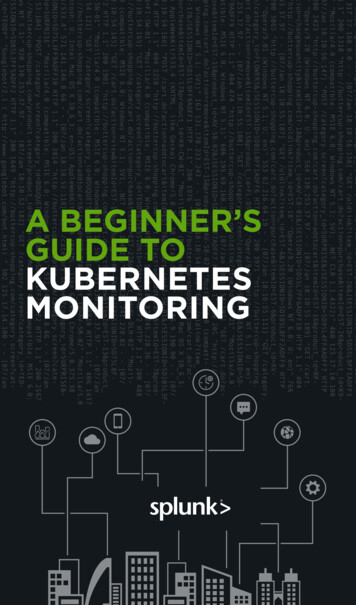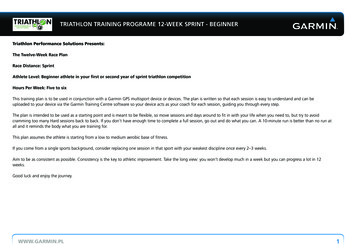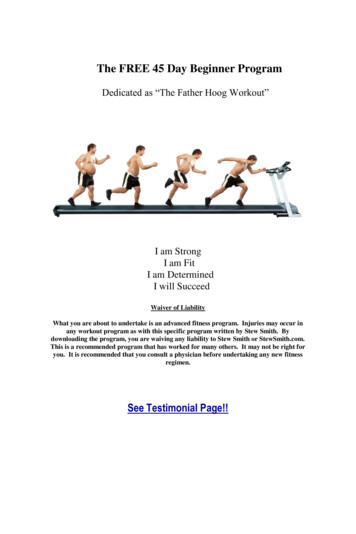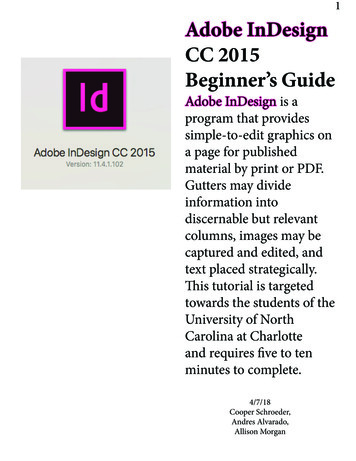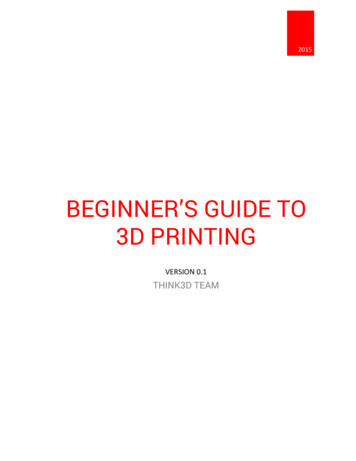
Transcription
2015BEGINNER’S GUIDE TO3D PRINTINGVERSION 0.1THINK3D TEAM
Welcome to think3D’s Beginner’s Guide to 3D Printing. This document is for peoplewho are completely new to 3D printing technology or who are looking at gainingadditional information on 3D printing technology. It is very imperative that 3D printingtechnology is going to change the world. Experts claim 3D printing is a much biggerrevolution than internet. We at think3D, completely agree to those viewpoints. In thisdocument, we shall be providing data to illustrate the true revolutionary nature of 3Dprinting.This document is structured into 6 chapters, (a) Introduction of 3D printing (b) Historyof 3D printing (c) 3D Printing Technology (d) 3D Printing Processes (e) 3D PrintingMaterials (f) 3D Printing Applications (g) 3D Printing Glossary.“3D printing” is an umbrella term for a host of processes and technologies that offer afull spectrum of capabilities for the production of parts and products in differentmaterials. One thing common in all these processes is the manner in which productionis carried out – layer by layer in an additive process. That is why “3D Printing” is alsocalled additive manufacturing in contrast to traditional methods of production that areprimarily subtractive in nature, also called as “subtractive manufacturing” ormolding/casting processes.Applications of 3D printing are emerging almost by the day, and, as this technologycontinues to penetrate more widely and deeply across industrial, maker and consumersectors, this is only set to increase. Most reputable commentators on this technologysector agree that, as of today, we are only just beginning to see the true potential of 3Dprinting.About think3D:think3D is India’s largest 3D printing platform covering all aspects of 3D printingtechnology like “Latest News”, “3D Printers”, “Print On Demand Services”, “3D DesignStore” & “3D Scanning Services”. This document is an attempt to provide the readers areliable authentic information on various terms and terminologies involved in 3Dprinting, its history, application areas and benefits.If you wish to contact us and gain more information on 3D printing technology, youcan always reach us at 040-3091 1007 or email us at info@think3d.in1
CHAPTER 01What is 3D Printing?2
In the 20th century, no other invention affected the mankind more than technology did.With the advent of computers in 1950s and internet in 1990s, the fundamental way ofdoing things has through a massive changes. These technologies made our livesbetter, opened up new avenues and possibilities and gave us a hope for the future. Butit generally decades for an ecosystem to be built across a particular technology totake it to masses and achieve the truly disruptive nature of that technology.It is widely believed that 3D printing or additive manufacturing (AM) has the vastpotential to become one of these technologies. There is a lot of coverage on 3Dprinting across many television channels, newspapers and online resources. Whatreally is this 3D printing that some have claimed will put an end to traditionalmanufacturing as we know it, revolutionize design and impose geopolitical, economic,social, demographic and environmental and security implications to our everydaylives?The most basic, differentiating principle behind 3D printing technology is that it is anadditive manufacturing process. And this is indeed the key because 3D printing is aradically different manufacturing method based on advanced technology that buildsup parts, additively, in layers at the sub mm scale. This is fundamentally different fromany other existing traditional manufacturing techniques.Traditional manufacturing process has evolved a lot over time from hand basedmanufacturing to the automated processes such as machining, casting, forming andmolding. Yet these technologies all demand subtracting material from a larger block –whether to achieve the end product itself or to produce a tool for casting or moldingprocesses — and this is a serious limitation within the overall manufacturing process.For many applications traditional design and production processes impose a numberof unacceptable constraints, including the expensive tooling, fixtures and the need forassembly for complex parts. In addition, the subtractive manufacturing processes,such as machining can result in up to 90% of the original block of material beingwasted.In contrast, 3D printing process can create objects directly by adding material layer bylayer in a variety of ways, depending on the technology used. Simplifying the ideologybehind 3D printing, for anyone that is still trying to understand the concept, it could belikened to the process of building something with Lego blocks automatically.3
3D printing is an enabling technology that encourages and drives innovation withunprecedented design freedom while being a tool-less process that reduces prohibitivecosts and lead times. Components can be designed specifically to avoid assemblyrequirements with intricate geometry and complex features created at no extra cost.3D printing is also emerging as an energy efficient technology that can provideenvironmental efficiencies in terms of both the manufacturing process itself, utilizingup to 90% of standard materials and throughout the product’s operating life throughlighter and stronger design.In recent years, 3D printing has gone beyond being an industrial prototyping andmanufacturing process as the technology has become more accessible to smallcompanies and even individuals. Previously, only big corporates used to own 3Dprinters as the scale and economics of owning 3D printer make it prohibitive forsmaller companies to own one. But with the rapid decline of the printer cost, thetechnology has become more affordable. Now a days, smaller and less capable 3Dprinters can be acquired for under 1000.This has opened up the technology to a much wider audience, and as the exponentialadoption rate continues apace on all fronts, more and more systems, materials,applications, services and ancillaries are emerging.4
CHAPTER 02History of 3D Printing5
The earliest 3D printing technologies first became visible in the late 1980’s, at whichtime they were called Rapid Prototyping (RP) technologies. This is because theprocesses were originally conceived as a fast and more cost-effective method forcreating prototypes for product development within industry. As an interesting sidenote, the first patent application for RP technology was filed by Dr. Kodama in Japan inMay 1980. But the full patent specification was not filed before the one year deadlineafter the application thus voiding the patent application.The first patent for 3D printing technology was issued in 1986 to Mr. Charles Hull forstereolithography apparatus (SLA). He invented the machine in 1983 and went on tocofound 3D Systems Corporation — one of the largest and most prolific organizationsoperating in the 3D printing sector today.3D Systems’ first commercial RP system, the SLA-1, was introduced in 1987. As withevery new technology, there were lot of researchers working on various ways to attainadditive manufacturing in 1980s. In 1987, Mr. Carl Deckard, who was working at theUniversity of Texas, filed a patent in the US for the Selective Laser Sintering (SLS) RPprocess. This patent was issued in 1989 and SLS was later licensed to DTM Inc, whichwas later acquired by 3D Systems.In 1989, one Mr. Scott Crump also filed a patent for Fused Deposition Modeling (FDM).He went to co-found another major 3D printing company called Stratasys Inc. As of2015, FDM has become the most popular 3D printing technology for entry levelmachines. This technology is based on open source RepRap model. The FDM patentwas issued to Stratasys in 1992. In Europe, 1989 also saw the formation of EOS GmbHin Germany, founded by Hans Langer. After a dalliance with SL processes, EOS’ R&Dfocus was placed heavily on the laser sintering (LS) process, which has continued togo from strength to strength. Today, the EOS systems are recognized around the worldfor their quality output for industrial prototyping and production applications of 3Dprinting. EOS sold its first ‘Stereos’ system in 1990. The company’s direct metal lasersintering (DMLS) process resulted from an initial project with a division of ElectroluxFinland, which was later acquired by EOS.Other 3D printing technologies and processes also emerged during these years,namely Ballistic Particle Manufacturing (BPM) originally patented by William Masters,Laminated Object Manufacturing (LOM) originally patented by Michael Feygin, SolidGround Curing (SGC) originally patented by Itzchak Pomerantz and ‘three dimensionalprinting’ (3DP) originally patented by Emanuel Sachs. And so the early ninetieswitnessed a growing number of competing companies in the RP market but only threeof the originals remain today — 3D Systems, EOS and Stratasys.6
Throughout the 1990’s and early 2000’s a host of new technologies continued to beintroduced, still focused wholly on industrial applications and while they were stilllargely processes for prototyping applications, R&D was also being conducted by themore advanced technology providers for specific tooling, casting and directmanufacturing applications. This saw the emergence of new terminology, namelyRapid Tooling (RT), Rapid Casting and Rapid Manufacturing (RM) respectively.In terms of commercial operations, Sanders Prototype (later Solidscape) andZCorporation were set up in 1996, Arcam was established in 1997, Objet Geometrieslaunched in 1998, MCP Technologies (an established vacuum casting OEM) introducedthe SLM technology in 2000, EnvisionTec was founded in 2002, ExOne was establishedin 2005 as a spinoff from the Extrude Hone Corporation and Sciaky Inc was pioneeringits own additive process based on its proprietary electron beam welding technology.These companies all served to swell the ranks of Western companies operating acrossa global market. The terminology had also evolved with a proliferation ofmanufacturing applications and the accepted umbrella term for all of the processeswas Additive Manufacturing (AM). Notably, there were many parallel developmentstaking place in the Eastern hemisphere. These technologies enjoyed some localsuccess but couldn’t really impact the global market around that time.During the mid-nineties, the sector started to show signs of distinct diversification withtwo specific areas of emphasis that are much more clearly defined today. First, therewas the high end of 3D printing, still very expensive systems, which were gearedtowards part production for high value, highly engineered, complex parts. At the otherend of the spectrum, some of the 3D printing system manufacturers were developingand advancing 3D printers that kept the focus on improving concept development andfunctional prototyping. These were built to be cost-effective systems. These machinesare prelude to today’s desktop machines. However, these systems were all still verymuch for industrial applications. Looking back, this was really the calm before thestorm.In 2007, the market saw the first system under 10,000 from 3D Systems, but thisnever quite hit the mark that it was supposed to. This was partly due to the systemitself, but also other market influences. The holy grail at that time was to get a 3Dprinter under 5000 — this was seen by many industry insiders, users andcommentators as the key to opening up 3D printing technology to a much wideraudience. For much of that year, the arrival of the highly anticipated Desktop Factorywas heralded as the one to watch. It came to nothing as the organization faltered inthe run up to production. Desktop Factory and its leader, Cathy Lewis, were acquired,7
along with the IP, by 3D Systems in 2008 and all but vanished. As it turned out though,2007 was actually the year that did mark the turning point for accessible 3D printingtechnology — even though few realized it at the time. Dr Bowyer conceived a conceptcalled RepRap. RepRap concept is to build an open source self-replicating 3D printer.The idea occurred in 2004 and the seed was germinated in the following years withsome heavy slog from his team at Bath, most notably Vik Oliver and Rhys Jones, whodeveloped the concept and built a working prototype of 3D printer using the depositionprocess. 2007 was the year the shoots started to show through and this embryonic,open source 3D printing movement started to gain visibility.But it wasn’t until January 2009 that the first commercially available 3D printer – in kitform and based on the RepRap concept – was offered for sale. This was the BfBRapMan 3D printer. Closely followed by Makerbot Industries in April the same year, thefounders of which were heavily involved in the development of RepRap until theydeparted from the Open Source philosophy following extensive investment. Since2009, a host of similar deposition printers have emerged with marginal unique sellingpoints (USPs) and they continue to do so. The interesting dichotomy here is that, whilethe RepRap phenomenon has given rise to a whole new sector of commercial, entrylevel 3D printers, the ethos of the RepRap community is all about Open Sourcedevelopments for 3D printing and keeping commercialization at bay.2012 was the year that alternative 3D printing processes were introduced at the entrylevel of the market. The B9Creator (utilizing DLP technology) came first in June,followed by the Form 1 (utilizing stereolithography) in December. Both were launchedvia the funding site Kickstarter — and both enjoyed huge success.As a result of the market divergence, significant advances at the industrial level withcapabilities and applications, dramatic increase in awareness and uptake across agrowing maker movement, 2012 was also the year that many different mainstreammedia channels picked up on the technology. 2013 was a year of significant growthand consolidation. One of the most notable moves was the acquisition of Makerbot byStratasys.Heralded as the 2nd, 3rd and, sometimes even, 4th Industrial Revolution by some, whatcannot be denied is the impact that 3D printing is having on the industrial sector andthe huge potential that 3D printing is demonstrating for the future of consumers. Whatshape that potential will take is still unfolding before us.8
CHAPTER 033D Printing Technology9
The entire 3D printing technology can be divided into 3 steps – (a) 3D Design (b)Slicing (c) 3D Printing. 3D digital model is the starting point for any 3D printingprocess. This digital model can be created using various 3D design softwares or canalso can be created using 3D scanning. Once the 3D model is created, it is then slicedinto layers thereby converting the design into a file readable by 3D printer. 3D printerwill then print this file layer by layer using the material given as input to the 3D printer.As stated, there are a number of different types of 3D printing technologies, whichprocess different materials in different ways to create the final object. Functionalplastics, metals, ceramics and sand are all routinely used for industrial prototyping andproduction applications. Research is also being conducted for 3D printing biomaterials and different types of food.Generally speaking though, at the entry level of the market, materials are much morelimited. Plastic is currently the only widely used material — usually ABS or PLA. Thereis also a growing number of entry level machines that have been adapted forfoodstuffs, such as sugar and chocolate.The different types of 3D printers each employ a different technology that processesdifferent materials in different ways. It is important to understand that one of the mostbasic limitations of 3D printing — in terms of materials and applications — is that thereis no ‘one solution fits all’. For example some 3D printers process powdered materials(nylon, plastic, ceramic, metal), which utilize a light/heat source to sinter/melt/fuselayers of the powder together in the defined shape. Others process polymer resinmaterials and again utilize a light/laser to solidify the resin in ultra-thin layers. Jettingof fine droplets is another 3D printing process, reminiscent of 2D inkjet printing, butwith superior materials to ink and a binder to fix the layers.Perhaps the most common and easily recognized process is deposition, and this is theprocess employed by the majority of entry-level 3D printers. This process extrudesplastics, commonly PLA or ABS, in filament form through a heated extruder to formlayers and create the predetermined shape. Because parts can be printed directly, it ispossible to produce very detailed and intricate objects, often with functionality built inand negating the need for assembly.However, another important point to stress is that none of the 3D printing processescome as plug and play options as of today. There are many steps prior to pressingprint and many more steps after the print is done. Apart from the realities of designingfor 3D printing, which can be demanding, file preparation and conversion can alsoprove time-consuming and complicated, particularly for parts that demand intricatesupports during the build process. However there are continual updates and upgrades10
of software for these functions and the situation is improving. Furthermore, once theobject is 3D printed, it needs to undergo finishing operations. Support removal is anobvious one for processes that demand support, but others include sanding, lacquer,paint or other types of traditional finishing touches, which all typically need to be doneby hand and require skill, time and patience.11
CHAPTER 043D Printing Processes12
SLAStereolithography (SL) is widely recognized as the first 3D printing process. It wascertainly the first to be commercialized. SL is a laser-based process that works withphotopolymer resins that react with the laser and cure to form a solid in a very preciseway. It is a complex process but simply put the photopolymer resin is held in a vat witha movable platform inside. A laser beam is directed in the X-Y axes across the surfaceof the resin according to the 3D data supplied to the machine (the .stl file), whereby theresin hardens precisely where the laser hits the surface. Once the layer is completed,the platform within the vat drops down by a fraction (in the Z axis) and the subsequentlayer is traced out by the laser. This continues until the entire object is completed andthe platform can be raised out of the vat for removal.Because of the nature of the SL process, it requires support structures for some parts,specifically those with overhangs or undercuts. These structures need to be manuallyremoved. In terms of other post processing steps, many objects 3D printed using SLneed to be cleaned and cured. Curing involves subjecting the part to intense light in anoven-like machine to fully harden the resin.Stereolithography is generally accepted as being one of the most accurate 3D printingprocesses with excellent surface finish. However limiting factors include the postprocessing steps required and the stability of the materials over time, which canbecome more brittle.13
DLPDLP (Digital Light Processing) is a similar process to stereolithography in that it is a3D printing process that works with photopolymers. The major difference is the lightsource. DLP uses a more conventional light source, such as an arc lamp with a liquidcrystal display panel, which is applied to the entire surface of the vat of photopolymerresin in a single pass, generally making it faster than SL.Also like SL, DLP produces highly accurate parts with excellent resolution, but itssimilarities also include the same requirements for support structures and post-curing.However, one advantage of DLP over SL is that only a shallow vat of resin is requiredto facilitate the process, which generally results in less waste and lower running costs.14
Laser Sintering / Laser MeltingLaser sintering and laser melting are interchangeable terms that refer to a laser based3D printing process that works with powdered materials. The laser is traced across apowder bed of tightly compacted powdered material, according to the 3D data fed tothe machine, in the X-Y axes. As the laser interacts with the surface of the powderedmaterial it sinters, or fuses, the particles to each other forming a solid. As each layer iscompleted the powder bed drops incrementally and a roller smoothens the powderover the surface of the bed prior to the next pass of the laser for the subsequent layerto be formed and fused with the previous layer.The build chamber is completely sealed as it is necessary to maintain a precisetemperature during the process specific to the melting point of the powdered materialof choice. Once finished, the entire powder bed is removed from the machine and theexcess powder can be removed to leave the ‘printed’ parts. One of the key advantagesof this process is that the powder bed serves as an in-process support structure foroverhangs and undercuts, and therefore complex shapes that could not bemanufactured in any other way are possible with this process. However, on thedownside, because of the high temperatures required for laser sintering, cooling timescan be considerable.15
Furthermore, porosity has been an historical issue with this process and while therehave been significant improvements towards fully dense parts, some applications stillnecessitate infiltration with another material to improve mechanical characteristics.Laser sintering can process plastic and metal materials, although metal sintering doesrequire a much higher powered laser and higher in-process temperatures. Partsproduced with this process are much stronger than with SL or DLP, although generallythe surface finish and accuracy is not as good.Extrusion / FDM / FFFDO NOT COPY3D printing utilizing the extrusion of thermoplastic material is easily the most commonand recognizable 3DP process. The most popular name for the process is FusedDeposition Modelling (FDM). However this is a trade name, registered by Stratasys, thecompany that originally developed it. Stratasys’ FDM technology has been aroundsince the early 1990’s and today is an industrial grade 3D printing process. However,the proliferation of entry-level 3D printers that have emerged since 2009 largely utilizea similar process, generally referred to as Freeform Fabrication (FFF), but in a morebasic form due to patents still held by Stratasys. The earliest RepRap machines and allsubsequent evolutions employ extrusion methodology. However, following Stratasys’patent infringement filing against Afinia there is a question mark over how the entrylevel end of the market will develop now, with all of the machines potentially inStratasys’ firing line for patent infringements.16
The process works by melting plastic filament that is deposited, via a heated extruder,a layer at a time, onto a build platform according to the 3D data supplied to the printer.Each layer hardens as it is deposited and bonds to the previous layer.Stratasys has developed a range of proprietary industrial grade materials for its FDMprocess that are suitable for some production applications. At the entry-level end ofthe market, materials are more limited, but the range is growing. The most commonmaterials for entry-level FFF 3D printers are ABS andPLA.The FDM/FFF processes require support structures for any applications withoverhanging geometries. For FDM, this entails a second, water-soluble material, whichallows support structures to be relatively easily washed away, once the print iscomplete. Alternatively, breakaway support materials are also possible, which can beremoved by manually snapping them off the part. Support structures, or lack thereof,have generally been a limitation of the entry level FFF 3D printers. However, as thesystems have evolved and improved to incorporate dual extrusion heads, it hasbecome less of an issue.In terms of models produced, the FDM process from Stratasys is an accurate andreliable process that is relatively office/studio friendly, although extensive postprocessing can be required. At the entry-level, as would be expected, the FFF processproduces much less accurate models, but things are constantly improving.The process can be slow for some part geometries and layer-to-layer adhesion can bea problem, resulting in parts that are not watertight. Again, post-processing usingAcetone can resolve these issues.17
Inkjet: Binder JettingThere are two 3D printing process that utilize a jetting technique.Binder jetting: Where the material being jetted is a binder, and is selectively sprayedinto a powder bed of the part material to fuse it a layer at a time to create/print therequired part. As is the case with other powder bed systems, once a layer is completed,the powder bed drops incrementally and a roller or blade smoothens the powder overthe surface of the bed, prior to the next pass of the jet heads, with the binder for thesubsequent layer to be formed and fused with the previous layer.!Advantages of this process, like with SLS, include the fact that the need for supports isnegated because the powder bed itself provides this functionality. Furthermore, arange of different materials can be used, including ceramics and food. A furtherdistinctive advantage of the process is the ability to easily add a full color palettewhich can be added to the binder.The parts resulting directly from the machine, however, are not as strong as with thesintering process and require post-processing to ensure durability.18
Inkjet: Material JettingMaterial jetting: a 3D printing process whereby the actual build materials (in liquid ormolten state) are selectively jetted through multiple jet heads (with otherssimultaneously jetting support materials). However, the materials tend to be liquidphotopolymers, which are cured with a pass of UV light as each layer is deposited.The nature of this product allows for the simultaneous deposition of a range ofmaterials, which means that a single part can be produced from multiple materialswith different characteristics and properties. Material jetting is a very precise 3Dprinting method, producing accurate parts with a very smooth finish.19
Selective Deposition Lamination (SDL)SDL is a proprietary 3D printing process developed and manufactured by McorTechnologies. There is a temptation to compare this process with the LaminatedObject Manufacturing (LOM) process developed by Helisys in the 1990’s due tosimilarities in layering and shaping paper to form the final part. However, that is whereany similarity ends.The SDL 3D printing process builds parts layer by layer using standard copier paper.Each new layer is fixed to the previous layer using an adhesive, which is appliedselectively according to the 3D data supplied to the machine. This means that a muchhigher density of adhesive is deposited in the area that will become the part, and amuch lower density of adhesive is applied in the surrounding area that will serve as thesupport, ensuring relatively easy “weeding,” or support removal.After a new sheet of paper is fed into the 3D printer from the paper feed mechanismand placed on top of the selectively applied adhesive on the previous layer, the buildplate is moved up to a heat plate and pressure is applied. This pressure ensures apositive bond between the two sheets of paper. The build plate then returns to thebuild height where an adjustable Tungsten carbide blade cuts one sheet of paper at atime, tracing the object outline to create the edges of the part. When this cuttingsequence is complete, the 3D printer deposits the next layer of adhesive and so onuntil the part is complete. SDL is one of the very few 3D printing processes that can20
produce full colour 3D printed parts, using a CYMK colour palette. And because theparts are standard paper, which require no post-EBMThe Electron Beam Melting 3D printing technique is aproprietary process developed by Swedish companyArcam. This metal printing method is very similar to theDirect Metal Laser Sintering (DMLS) process in terms ofthe formation of parts from metal powder. The keydifference is the heat source, which, as the namesuggests is an electron beam, rather than a laser, whichnecessitates that the procedure is carried out undervacuum conditions.EBM has the capability of creating fully dense parts in avariety of metal alloys and as a result the technique hasbeen particularly successful for a range of productionapplications in the medical industry, particularly forimplants. However, other hi-tech sectors such asaerospace and automotive have also looked to EBMtechnology for manufacturing fulfillment.21
CHAPTER 053D Printing Materials22
The materials available for 3D printing have come a long way since the early days ofthe technology. There is now a wide variety of different material types that aresupplied in different states (powder, filament, pellets, granules, resin etc.)Specific materials are now generally developed for specific platforms performingdedicated applications (an example would be the dental sector) with materialproperties that more precisely suit the application. There are way too many suchproprietary materials from many different 3D printer vendors. In this article, we shalllook at the most popular types of generic materials available.PlasticsNylon, or Polyamide, is commonly used in powder form with the sintering process or infilament form with the FDM process. It is a strong, flexible and durable plastic materialthat has proved reliable for 3D printing. It is naturally white in color but it can becolored - pre or post printing. This material can also be combined (in powder format)with powdered aluminum to produce another common 3D printing material forsintering — Alumide.ABS is another common plastic used fo
In recent years, 3D printing has gone beyond being anindustrial prototyping and manufacturing process as the technology has become more accessible to small companies and even individuals. Previously, only big corporates used to own 3D printers as the scale and economics of owning 3D printer make it prohibitive for smaller companies to own one.File Size: 523KB

